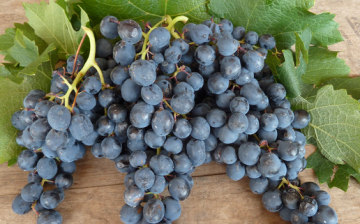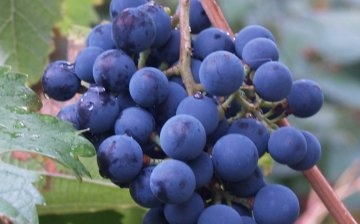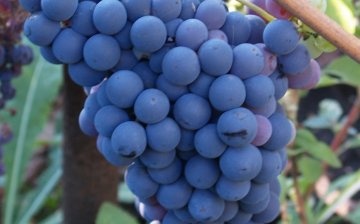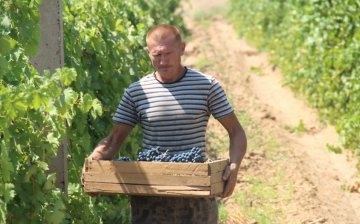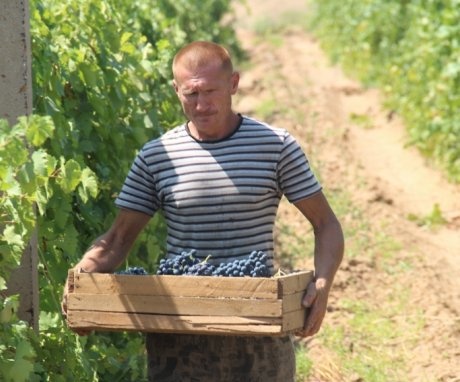North Saperavi grapes: features of the variety and cultivation
Saperavi is a traditional variety grapes for winemaking, in Georgia it remains one of the most widespread. It is most often used to make red dessert wine and several varieties of fortified wines, but the berries can also be eaten fresh. Saperavi North is a hybrid variety of Russian selection, adapted for growing in colder climates. It was the result of the work of the employees of VNIIViV them. ME AND. Potapenko, who crossed Saperavi and Severny vines to obtain a cold-resistant hybrid.
Content:
The appearance of the grapes and features
Northern Saperavi is considered a medium late variety, the berries ripen on the 141st day. The plant has small three-lobed leaves, the underside of the leaf plate is covered with bristly pubescence. Harvest begin to collect from mid-September, with a delay, the berries quickly begin to crumble.
The Saperavi northern grape variety is considered winter-hardy, therefore, unlike its ancestor, it can grow not only in warm Georgia.
They have been breeding it since 1958, today it is actively cultivated in the North Caucasian and Lower Volga regions, it is widespread in Dagestan, Krasnodar Territory, North Ossetia, Astrakhan Region, etc. It is resistant to many diseases and pests: the vines are almost not infect gray mold, which is a common problem with other varieties.
The northern Saperavi grapes give large clusters, their weight reaches 110 g. The harvest is harvested from mid-September, by which time dark blue berries, covered with a natural wax coating, ripen. The berries are small in size, they weigh 0.7-1.2 g. Dark pink juice has a high sugar content, in ripe berries it can reach 28%.
Growing rules
Winter-hardy grapes Northern Saperavi is one of the most suitable for the conditions of the southern regions of Russia. It is relatively undemanding to care for, and can withstand temperatures as low as -20 degrees, although early frosts can be dangerous for it.
To get a good harvest, there are several important principles to keep in mind. cultivation Location on:
- Variety grapes prefers lighted areas: with a lack of sun, the berries will ripen much longer and will be much more acidic. A well-lit area must be found for the vines, but it must be protected from the cold wind.
- Northern Saperavi belongs to the moisture-loving varieties, therefore it is recommended to plant it in areas with good moisture supply or with mounted system artificial irrigation.
- The distance between the bushes should be 2.5x1.5 m so that they have enough room to grow and bear fruit. So that the yield does not decrease, it is necessary to regularly remove perennial shoots, leaving room for the growth of annual green mass.
- The optimum acidity of the soil is 6.5-7.0, subject to this condition grape can bear fruit well on different types of soil.The soil needs drainage: moisture should not stagnate, otherwise the roots may begin to rot.
- In the southern regions, young vines are planted in October-March, as the soil does not freeze during the entire cold season. In colder regions, planting should be done before budding begins. After landing the soil is watered and mulch, for feeding you can use a comprehensive mineral fertilizer.
Any grape variety requires proper care. Not all gardeners know that even touching the berries is once again undesirable: this leads to the loss of a valuable wax coating that protects them from damage. When harvesting, the bunches are not plucked, but carefully cut with a pruner to prevent damage to the vine itself.
When growing, rationing of bunches is necessary: in good years, too many fruits ripen, and the plant gives all its strength to the ripening of the bunches.
At the same time, there is no supply of nutrients left for growing new shoots, as a result of which the yield next year will be significantly reduced. One bush of the Saperavi Severny variety can withstand up to 35 shoots, yielding a large harvest annually, all excess must be removed regularly.
Tips for winegrowers
Although Northern Saperavi is a winter-hardy variety, you need to know a few basic rules that will help the plant survive the cold season safely. The roots of the plant are the least protected from the cold, they are unable to survive temperatures below -10 degrees, so they must be covered for the winter.
However, winter-hardy varieties are characterized by high substitution power. Each underground fruit bud has 2-3 additional leaf buds, they are more resistant to low temperatures. Even if the buds freeze in winter, the bush will be able to recover rather quickly. You can check how successfully the bush survived the winter during trimming... Juice should appear on fresh cuts - gardeners say that such a "vine cries". If moisture does not appear, this indicates that the bush will require a long recovery.
The most frost-resistant part of the plant is the vine, it can withstand up to 20 degrees below zero.
Even after the most severe winter, it is able to give new roots, and the plant will again delight the gardener with a good harvest. Many years of testing and careful selection made Saperavi Severnyi one of the most convenient varieties for cultivation in the southern regions and the middle lane, which made it possible to actively use it for winemaking. Growing Saperavi northern on the site will not cause much trouble and will allow you to get a good harvest in a relatively short time.
More information can be found in the video.



